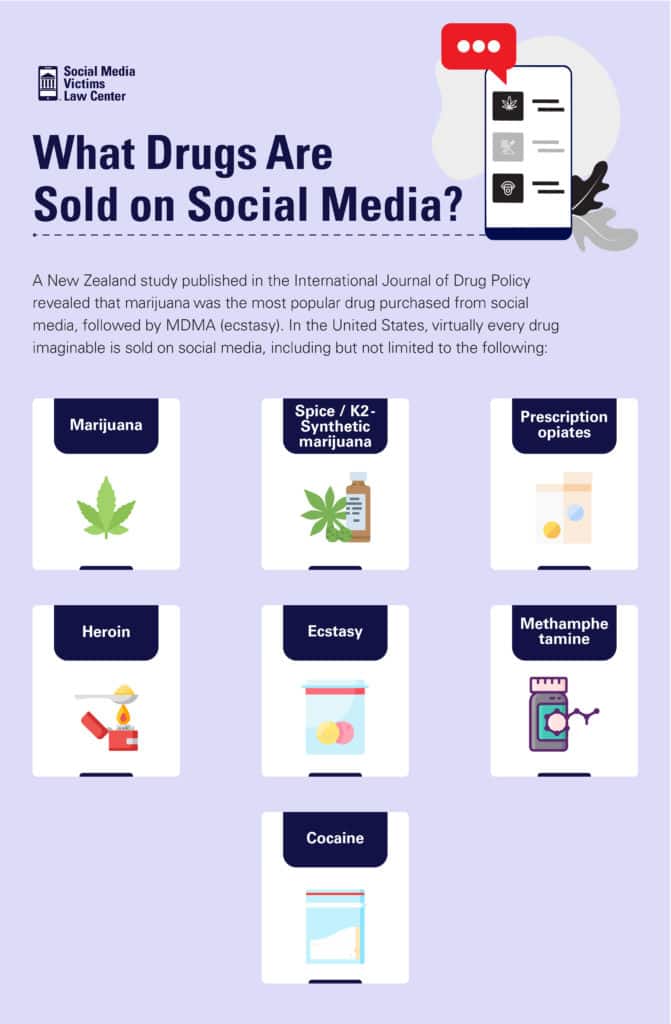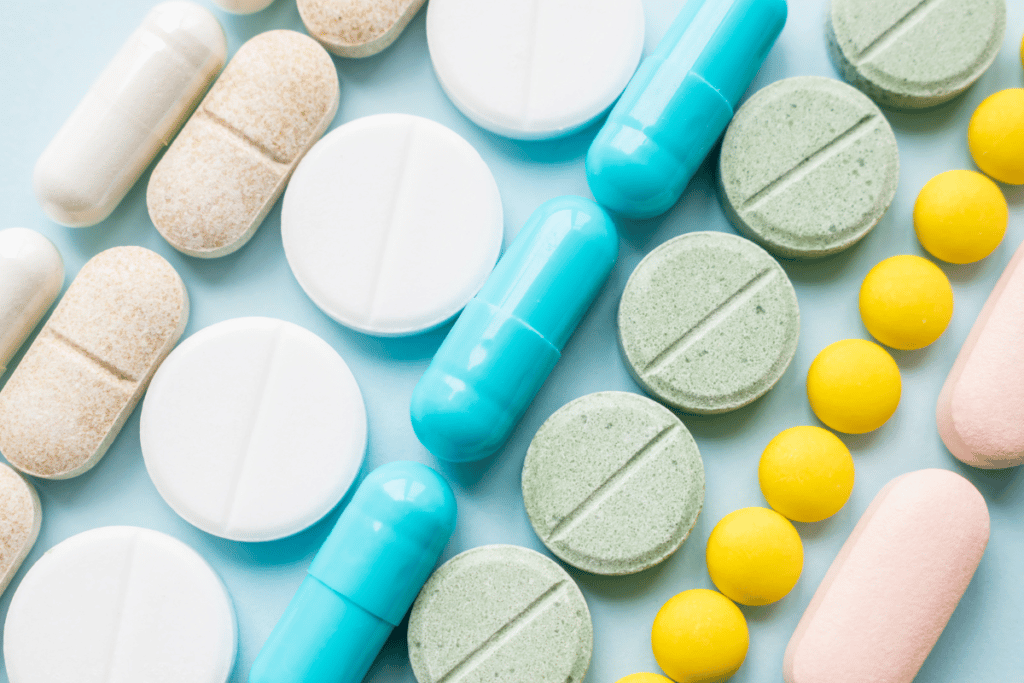Social Media and Illegal Drugs
Drugs are synonymous with many social media platforms, where drug dealers easily advertise their products to teens. Many of the drugs sold on social media are fake pills made of deadly fentanyl. The result has been the sudden death of hundreds of children.
 Written and edited by our team of expert legal content writers and reviewed and approved by Attorney Matthew Bergman
Written and edited by our team of expert legal content writers and reviewed and approved by Attorney Matthew Bergman
- Content last updated on:
- June 12, 2025
Written and edited by our team of expert legal content writers and reviewed and approved by

- Content last updated on:
- June 12, 2025
What You’ll Learn
- Online Drug Dealers on Social Media
- What drugs are sold on social media?
- Which social media platforms allow illegal drug trafficking?
- How is social media addiction like drug addiction?
- Does social media addiction lead to drug addiction?
- The Effects of Drug Addiction
- Recognizing the Signs
- Getting Help for Your Teen
- Hold the Social Media Companies Accountable
It’s a sad fact that social media platforms have made illegal drugs more accessible to youngsters than ever before. Before the easy access of social media, obtaining drugs required finding an in-person drug dealer in the seedy part of town. Now, drug dealers can easily advertise their products to teens and coordinate sales under the radar.
Online drug trafficking on social media has become big business. With social media’s large user bases, dealers seek to maximize profits. Teens can purchase nearly any drug they want from the comfort of their bedrooms and have them delivered within minutes. Many of these drugs are fake pills made of deadly fentanyl, a synthetic opiate drug, which has resulted in the sudden death of hundreds of children. A dose the size of a pinch of salt can kill individuals who lack tolerance, and a single pill may contain enough fentanyl to kill multiple people.
The Drug Enforcement Administration issued a Public Safety Alert warning about fentanyl known as the “One Pill Can Kill” campaign. Its purpose is to warn the public about the dangers of purchasing pills on social media because they may be fake… and deadly.
Technically, all social media platforms prohibit the sale of drugs. But teens are very online savvy and have learned sneaky ways to find a drug dealer on social media. The DEA has found evidence that drug activity is rampant on all of the major platforms.
In a CBS News Investigation, reporters created fake profiles across Instagram, Snapchat, and TikTok claiming to be 18-year-old high school students. One claimed to be actively searching for drugs, and another used hashtags to indicate they were experiencing sadness, depression, and anxiety.
The first investigator found a dealer within 48 hours. The reporter with the profile claiming depression and anxiety was fully entrenched in the drug culture on Instagram by the third day.
In 2019, Instagram replaced Twitter as the most popular social media platform for drug trafficking, according to West Virginia University. Experienced social media users can buy drugs on Instagram with as few as two clicks. Instagram’s algorithm makes it especially easy for drug buyers to find multiple dealers by simply liking a dealer’s post.
Snapchat is also a popular social media site for pursuing online drug purchases. NBC News confirmed that drug transactions on Snapchat led to deaths due to fentanyl poisoning in at least 19 states.
While social media platforms attempt to block content that contains drug-related verbiage, experienced social media users and social media drug dealers know how to circumvent these filters using slang terms instead of drug names, such as “pilz” or “Xanaz.”
Another common method drug dealers use to bypass the filters is the use of “emojis: to advertise their drugs for sale. For example, using the emoji of a chocolate bar to depict Xanax or a green dragon to depict heroin.
These symbols are designed to appear as innocent posts while making it clear to a prospective buyer that drugs are for sale. Once the initial contact is made, the conversation continues privately, often through an encrypted messaging app such as Telegram or Whatsapp.
Sadly, social media use itself has been known to become addictive which can in turn lead to substance abuse addiction. Social media addiction and drug addiction create the same responses in the brain’s reward center. A study by Michigan State University revealed that individuals who are susceptible to social media addiction may also be susceptible to drug addiction, making them a prime target by online drug dealers over the very medium in which they spend a sizable portion of their time.
Parents of teens who are heavy users of social media should be on the lookout that their child may be using social media platforms to obtain drugs and may have a substance use disorder. There are several recognizable signs.
Changes in appetite
Disrupted sleep
Changes in friends
Poor personal hygiene and grooming
Reduced academic performance.
Loss of interest in activities previously enjoyed.
Deteriorating relationships
It is important not to underestimate the hold that substance addiction can have on your child. An addicted child cannot just stop using drugs. They will require outpatient treatment at a minimum and may even need inpatient therapy as well.
Social media was intended as a means to reach out to others. However, social media platforms are drawing children in without parental consent, then allowing drugs to be pushed on them. However, there are steps parents can take.
If your teen was harmed by drugs obtained through social media, it’s important to understand what legal options you may have. The experienced attorneys at The Social Media Victims Law Center can help you understand the legal landscape surrounding social media and drugs. Contact the Social Media Victims Law Center today to schedule a free consultation.
Social media platforms have made illegal drugs more accessible to children than ever before. Prior to social media, obtaining drugs required finding an in-person drug dealer in the seedy part of town.
In 2022, one of the effects that social media has had on society is that teens can purchase virtually any drug they want from the comfort of their bedrooms and have them delivered to the door within minutes.
According to the Centers for Disease Control and Prevention (CDC), 103,550 overdose deaths occurred in the United States in November 2022. This is a record, and the CDC believes overdose numbers are underreported.
The New York Times reported that a large proportion of these deaths can be attributed to fake drugs that were actually fentanyl, a synthetic opiate drug.
Online Drug Dealers on Social Media
Kids are faced with constant exposure to drugs on social media. Drug trafficking has become big business on social media, and online dealers seek to maximize profits.
Prescription drugs are popular because teens and young adults are accustomed to seeing peers taking prescription drugs for anxiety, depression, ADHD, or other physical and mental health issues. This contributes to the illusion that they are safer drugs because they are available by prescription.
A Single Pill May Be Deadly
The Drug Enforcement Administration (DEA) has issued a Public Safety Alert warning known as the “One Pill Can Kill” campaign. Its purpose is to warn the public about the dangers of purchasing pills on social media because they may be fake.
Many of the pills sold on social media are manufactured by Mexican drug cartels. As many as two out of five pills seized and tested by the United States contains lethal doses of fentanyl, according to NBC News.
Fentanyl is a synthetic opioid that is 100 times stronger than morphine and 50 times more potent than heroin, but it is faster and cheaper to produce. According to the DEA, the ingredients in these pills may be obtained from China and India and could also include methamphetamine and other dangerous unregulated chemicals.
A dose the size of a pinch of salt can kill individuals who lack tolerance, and a single pill may contain enough fentanyl to kill multiple people.
The fentanyl deaths of youth and young adults has prompted our team to file lawsuits against Snapchat representing families of victims. Was your family affected?

What drugs are sold on social media?
A New Zealand study published in the International Journal of Drug Policy revealed that marijuana was the most popular drug purchased from social media, followed by MDMA (ecstasy). In the United States, virtually every drug imaginable is sold on social media, including but not limited to the following:
- Marijuana
- Spice / K2 – Synthetic marijuana
- Prescription opiates
- Heroin
- Ecstasy
- Methamphetamine
- Cocaine
Which social media platforms allow illegal drug trafficking?
Technically, all social media platforms prohibit the sale of drugs, but teens know how to find a drug dealer on social media. The DEA has found evidence that drug activity is rampant on all of the major platforms.
Drug Slang
Slang terms are used across social media platforms but they are especially common when talking about drugs. Social media platforms attempt to block content that contains drug-related verbiage, but experienced social media users and social media drug dealers know how to circumvent these filters.
One common method of bypassing the filters is to use misspellings, such as “pilz” or “Xanaz.” Terms such as “cush” may be used for marijuana. However, these terms constantly evolve by necessity as the platforms learn the terminology and strengthen their filters.
According to the DEA, social media drug dealers typically advertise their drugs for sale, but rather than use slang terminology, they use emojis.
Common Emoji Codes for Drugs
- A blue square with a white P in the center to depict the opiate drug Percocet
- A chocolate bar to depict Xanax
- A palm tree to depict marijuana
- A royal blue heart to depict meth
- A green dragon to depict heroin
These symbols are designed to appear as innocent posts to the uninformed while making it clear to a prospective drug buyer that drugs are for sale. Once the initial contact is made, the conversation continues privately, often through an encrypted messaging app such as Telegram or Whatsapp.
Instagram Drugs
In 2019, Instagram replaced Twitter as the most popular social media platform for drug trafficking, according to West Virginia University.
Experienced social media users know how to buy drugs on Instagram in as little as two clicks. Instagram’s algorithm makes it especially easy for drug buyers to find multiple dealers by simply liking a dealer’s post. A reporter for the Washington Post tried this, and Instagram filled the reporter’s feed with drug dealer ads.
Nonprofit research initiative Tech Transparency Project has observed that Instagram enables teens to find drug dealers by auto-filling the search field when teens type in a search. If the teen attempts to search for a term that triggers Instagram’s filters, Instagram suggests an alternative search term that is not blocked.
In a CBS News Investigation, reporters created fake profiles across Instagram, Snapchat, and TikTok claiming to be 18-year-old high school students. The first user claimed to be actively searching for drugs, and the second profile used hashtags that indicated the user was experiencing sadness, depression, and anxiety.
The first investigator found a dealer within 48 hours. The investigator that advertised experiencing depression and anxiety was fully entrenched in the drug culture on Instagram by the third day, including a picture of someone snorting cocaine.
Snapchat Drugs
NBC News has confirmed that drug transactions on Snapchat have led to deaths due to fentanyl poisoning in at least 19 states. Snapchat drugs seem to find users whether or not Snapchat users know how to find them.
Dr. Laura Berman, a relationship therapist who makes regular appearances on Today, is the mother of a 16-year-old boy who was killed by fentanyl poisoning when he thought he ordered Xanax or Percocet through a drug dealer that connected with him on Snapchat.
According to Dr. Berman, he received a menu of drugs in attractive colors intentionally designed to appeal to teens. The drug was delivered to the house, and he died in his room.
TikTok Promotes Drug Content to Young Users
In a 2021 Wall Street Journal investigation, reporters set up several fake accounts for 13- to 15-year-old users to discover what types of content would be served. One account belonging to a 13-year-old received 569 videos about drug use, including cocaine and meth addiction, with promotional videos for online sales of drugs and paraphernalia. Hundreds of similar videos also appeared in the other user feeds.

How is social media addiction like drug addiction?
Drug addiction and social media addiction create the same responses in the brain’s reward center. Just as people with substance use disorders rely on drugs and alcohol to increase neurotransmitter activity, social media users engage their reward centers by seeking social rewards on their platforms of choice.
Social media users who are addicted cannot stop looking at social media on their own. If forced to abstain, they experience physical withdrawal symptoms similar to drug withdrawal. They may respond in a fashion similar to how substance users respond and stop at nothing to seek access to social media.
A study by Michigan State University revealed that individuals who are prone to social media addiction exercised poor decision-making skills in a similar fashion as individuals addicted to drugs.
This study points to the possibility that individuals who are susceptible to social media addiction may also be susceptible to drug addiction. This adds to the risks of social media addiction, as these individuals are being targeted by drug dealers on a medium in which they spend a large portion of their time.
Does social media addiction lead to drug addiction?
Social media addiction could lead to substance abuse addiction. In addition to the constant barrage of social media advertising by drug dealers, problematic social media users may find social media progressively less satisfying over time.
The Progress of Addiction
As social media addiction progresses, the user experiences deepening depression and other ill effects. Eventually, social media is not satisfying anymore. Just as with substance use disorders, the effects of social media addiction include an increasing tolerance to the dopamine release triggered by a reward.
A depressed young person who no longer experiences the same rush from these rewards may turn to drugs and alcohol in hopes of experiencing the highs they experienced when they first started using social media.
The Mental Health Effects of Problematic Social Media Use
Problematic social media users often begin using social media as a form of relief from mental health issues such as depression, anxiety, and loneliness. Instead of finding relief, their issues are exacerbated.
While this is occurring, they are constantly exposed to content that glamorizes drugs and entices them to try them.
The effects of problematic social media use place children in a high-risk category. According to the DEA, the following characteristics are risk factors:
- Low grades
- Cyberbullying
- Low self-esteem
Child Mind Institute has observed that nearly half of children with untreated mental health issues turn to substance abuse. These substances temporarily alleviate mental health symptoms but make them worse in the long run.
For example, pressure to fit in increases anxiety. Problematic social media use and, ultimately, drugs may help them feel more socially confident for a short time. In the long run, both of these habits result in further social ostracization.

The Effects of Drug Addiction
Drug use alters the brain chemistry by impacting the reward system, which impacts instinct and mood through the release of unnaturally high levels of dopamine, a feel-good neurotransmitter.
Short-term and long-term consequences of drug addiction include the following:
- Poor academic performance
- Increased mental health issues
- Social alienation
- Legal troubles
Substance Use and the Adolescent Brain
The adolescent brain is still developing. A 2018 study in Frontiers in Behavioral Neuroscience analyzed human and animal brain development and found that substance use during adolescence is associated with the following:
- Deficits in neurodevelopment
- Damage to neurocircuits associated with learning, memory, and decision-making
- Negative impacts on neurocognitive functions
When the brain is assaulted by such damaging substances while it is still developing, there is a risk that the damage could be permanent. The resulting symptoms may include impairments of the following:
- Stress response
- Risk-based decision-making
- Impulse control
- Executive function
- Learning
- Memory
- Immune system responses
Substance Use and Physical Health
According to the National Library of Medicine, substance abuse during adolescence can contribute to higher risks of the following:
- Heart disease
- High blood pressure
- Sleep disorders
- Greater risk of being addicted later in life
Teens and Alcohol
A 2022 survey found that adolescents most commonly use alcohol, nicotine, and cannabis. In addition, almost half of teenagers reported using alcohol over the past year, according to 2022 data from the National Institute on Drug Abuse.
Underage alcohol consumption is so common that people ages 12 to 20 consume approximately 10 percent of all alcohol consumed in the United States. It is the most widely misused substance among teens, according to the National Library of Medicine.
Like other drugs, alcohol can have permanently damaging effects, including:
- Death
- Injuries
- Drunk driving
- Unprotected sex
- Behavioral issues at school
- Academic issues
- Increased risk of alcoholism as an adult
- Brain damage
- Disruptions to the brain communication pathways
- Mood, behavior, and cognitive disorders
Long-term abstinence can at least partially repair thinking and memory skills.
Recognizing the Signs
The National Institute on Drug Abuse has provided the following list of signs that your child may have a substance use disorder:
- Changes in appetite
- Disrupted sleep
- Changes in friends
- Poor personal hygiene and grooming
- Reduced academic performance
- Loss of interest in activities previously enjoyed
- Deteriorating relationships
If you observe these changes in your teen, additional methods to identify substance use include the following:
- When conversing with your child, make note of any unusual smells.
- Check to see if your child’s eyes are red, swollen, or glassy.
- Observe your child’s pupils and assess whether they are dilated or contracted.
- Search your child’s room for evidence of substance use.
Getting Help for Your Teen
If your child is using a substance, it is crucial that you take immediate action. The first step is to establish communication with your child. It will be important for your child to see you as a safe, non-judgmental support person. Be honest about what you have found, but show a spirit of compassion and support.
If your child’s addiction has progressed, they may resist communication and see you as a barrier to obtaining the substance they believe they need in order to function. If the addiction has reached this point, you will need outside intervention.
It is important not to underestimate the hold substance addiction has on your child. Substance abuse may have started with an initial choice, but drug addiction is a disease, not a choice. Your child cannot just stop using drugs. They will require outpatient treatment at a minimum and possibly inpatient therapy.
Your pediatrician or family physician is a great place to get a referral.
Hold the Social Media Companies Accountable
If social media use has caused your child to turn to drugs, you are not to blame. Social media platforms are drawing children in without parental consent, then allowing drugs to be pushed on them, or, in some cases, the platforms themselves are pushing the drugs.
The only way to stop social media platforms from continuing to harm children is to take a stand. Contact us today for a free consultation.
Frequently Asked Questions
For individuals and children who have been
We only handle cases on a contingent fee basis. This means that we are paid a portion of any recovery obtained in the case and you do not owe us any attorneys’ fees if the lawsuit does not result in a recovery.
Every case is unique. Our attorneys will work with your family to evaluate your potential case and help you evaluate whether filing a lawsuit or other legal proceeding is in your family’s best interest. Generally speaking, the types of cases we handle involve serious mental health effects, including attempted or completed suicide, eating disorders, inpatient mental health treatment, or sexual trafficking/exploitation that was caused by or contributed to through addictive or problematic social media use by teens and young adults.
We are a law firm based near Seattle, WA comprised of lawyers who have spent their entire careers representing victims who have been harmed by dangerous products. We are also parents. Shocked and troubled by the recent revelations about the harm caused to teens and young adults by social media platforms, which powerful technology companies have designed to be highly addictive, Social Media Victims Law Center was launched specifically to help families and children who have suffered serious mental harm or exploitation through social media use to obtain justice.
Contact Us Today
